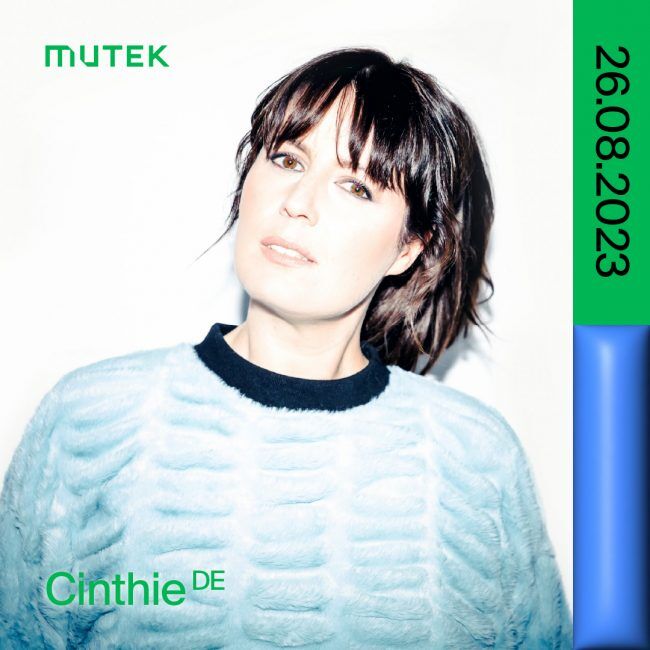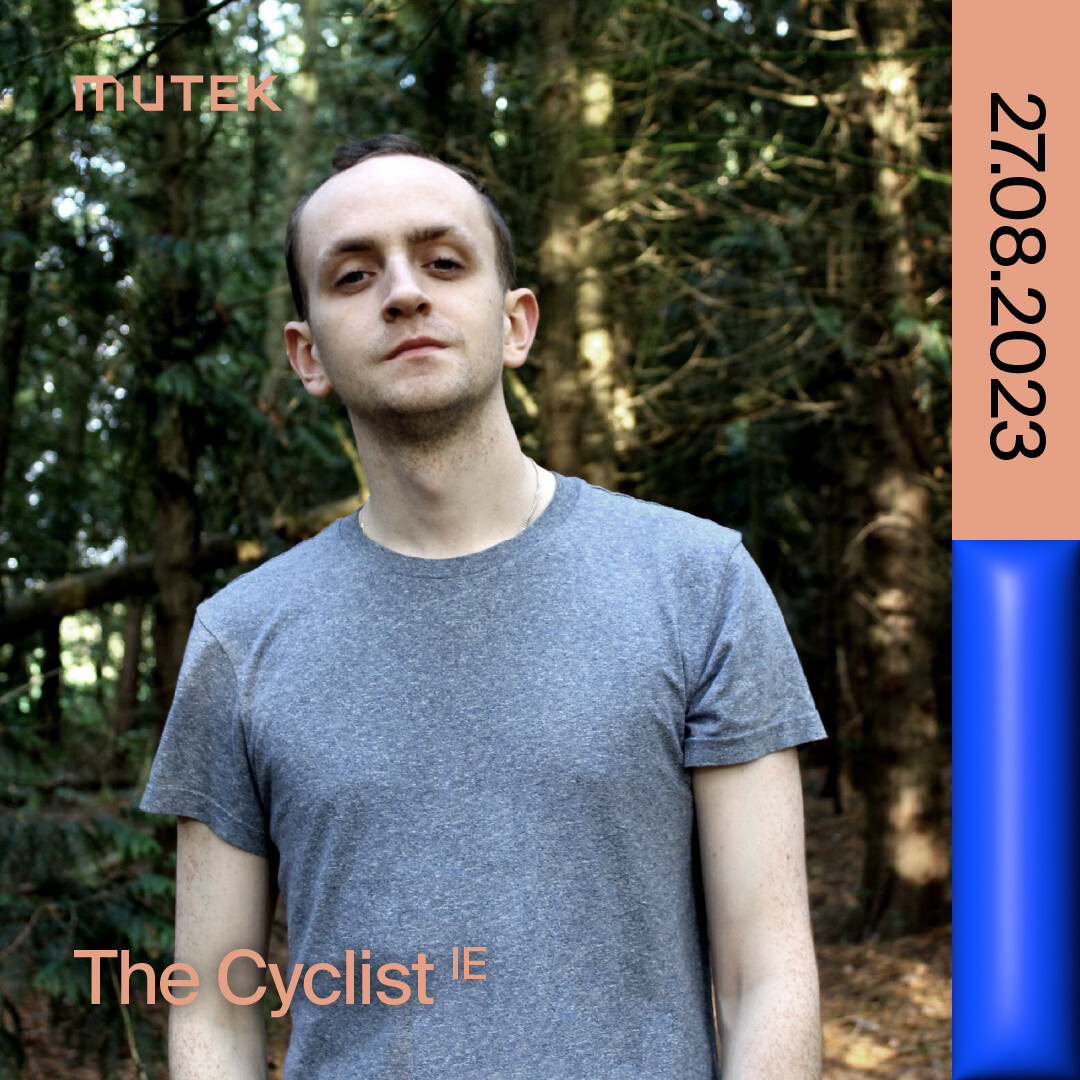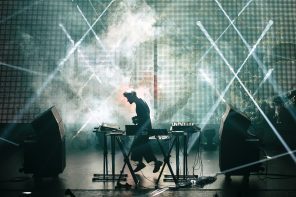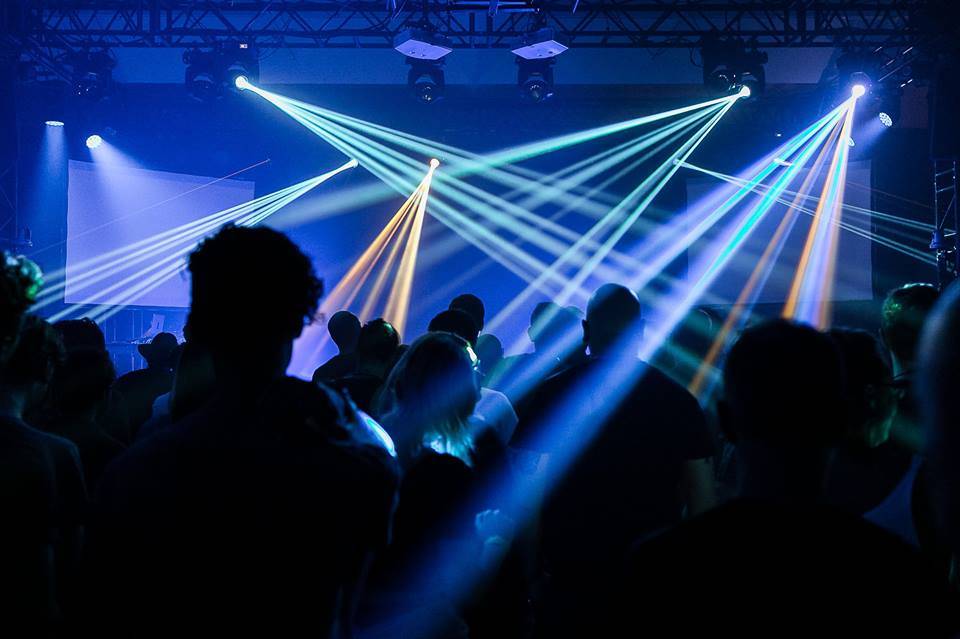
Credit: Trung Dung Nguyen
I have a confession to make. I moved to Montreal in 1999, one year before MUTEK took the city and the festival scene by storm, and, in sixteen years, I have only managed to go to a handful of its amazing shows – mostly to the Saturday nights held at Metropolis where four-on-the-floor usually holds sway. The thing is, I’m a house head. I’m thoroughly addicted to the kick, the clap and the good old hi hat. Give me a choice between something on the electroacoustic end of the spectrum and DJ So-and-so, and I will go to hear the ones and twos get worked every time. So when I was given the chance, this year, to experience MUTEK in its entirety, I took it as an opportunity to expand my musical horizons and survey the state of the art in digital media. Here are a few scattershot impressions of my five nights at the festival.
THE VISUALS WERE SCARY GOOD
This was not your average kaleidoscopic, neo-hippy rave bullshit. It wasn’t Betty Boop dancing the Charleston in an endless video loop. The visuals at MUTEK were startlingly sophisticated and of a higher order than what I’m used to seeing at clubs and parties.
The first to catch my eye were provided by Montreal-based media artist, Hugues Clément, as part of the kick-off to the evening Nocturne series at the Musée d’Art Contemporain. Set to the bass-centric, latin-inspired rhythms of Mexico City’s Siete Catorce, Clément’s cotton candy-coloured backgrounds and interiors were furnished by glitchy, idealized 3D renditions of chairs, chandeliers and a rather unsettling bathtub overflowing with lavender bubbles. This, intercut with gaseous, pastel-hued forms and oily rainbow sheens, provided a sickly-sweet counterpoint to Catorce’s sinister narco soundtrack.
Even the tamer visual components that accompanied performances by dance-oriented artists like Galcher Lustwerk for Nocturne 4 (an unnamed VJ), and Project Pablo and Local Artist for Nocturne 5 (VJ Tetsouille and VJ Cafrine respectively), were beyond elegant in their patterning, and worked in perfect unison with the music.
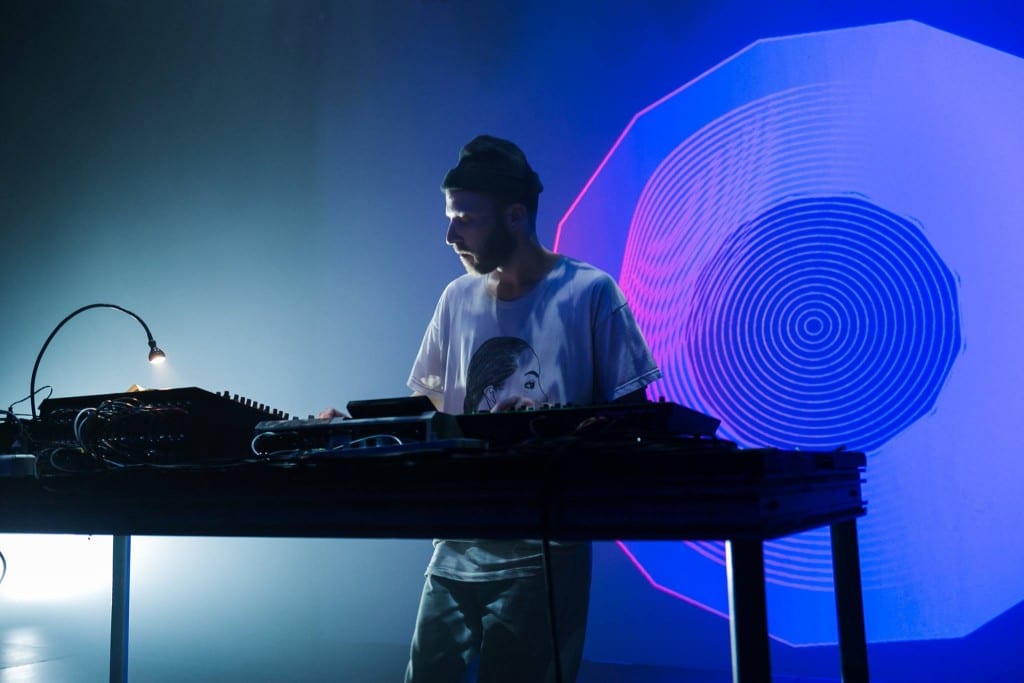
Credit: Vivien Gaumand
In terms of wild eye candy, though, the real showstopper of the festival had to belong to the performance of Swiss-born Nepalese-Tibetan singer and musician, Aïsha Devi. Born of source material from visual artist, Tianzuo Chen, Emile Barret’s imagery was a strange amalgamation of psychedelic collage and abstract video game, played live and created especially for Devi’s new album, Of Matter And Spirit. The object of the game was far from clear, but Barrett appeared to be guiding a quintet of gently rolling marbles along the infinitely winding highways and overpasses of some metropolis of the inner mind, its washed out colours and flattened perspective giving it a fever dream quality. And then things got really weird. Mandalas and sigils. Pop advertising and tarot symbols. Dancing PVC-clad shamanic priestesses and some dude wearing an astronaut helmet modified to take the business end of a giant bong, the words “TRIP” and “JERK OFF IN PEACE” flashing intermittently across the screen. All this, of course, to the sound of Devi chanting, mantralike, over her particularly tribal brand of bass music. It felt like I had taken a hit of microdot. I loved every second of it.
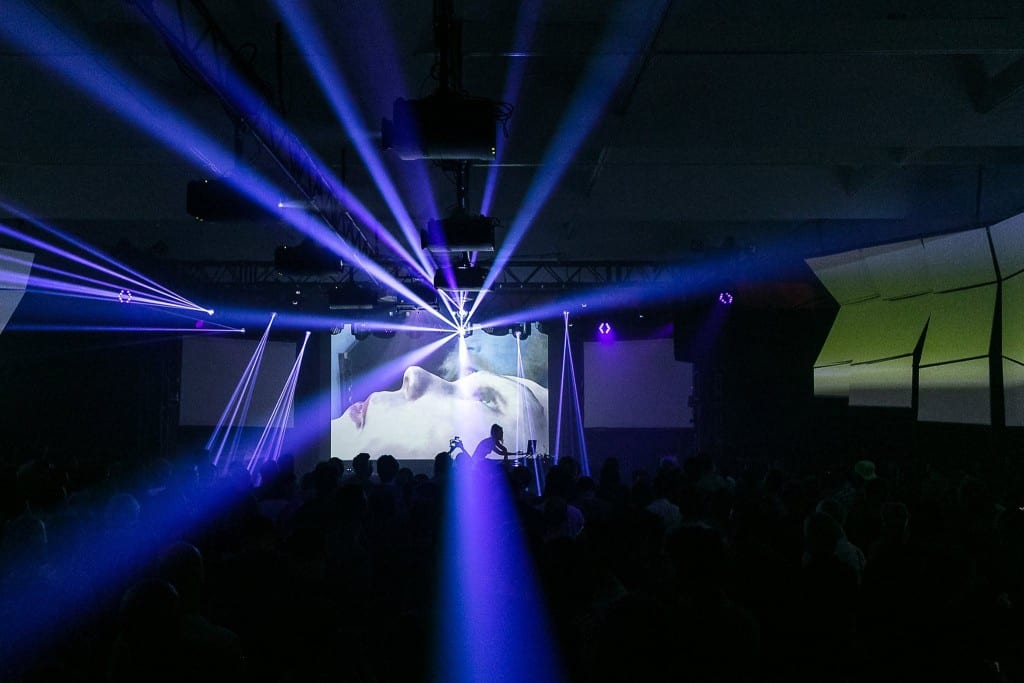
Credit: Vivien Gaumand
DECONSTRUCTION IS STILL A THING
Remember trance music? The breakneck tempos? The giant builds? The sirens and saw waves bearing down on you like you were a piece of timber about to be cut and planed into two-by-fours? There it was, the bastard stepchild of electronica ringing painfully loud and all too clear in the main room of the MAC for Nocturne 2.
The culprit in question was Italian sound artist, Lorenzo Senni, and he was presenting AAT (or Advanced Abstract Trance). Quietly sitting down behind his laptop, he paused to take a measured sip of beer before doing the heavy work of pressing play, then proceeded to pummel and confound the audience with deftly chopped sonic relics of raves gone by. Each arpeggiated build was abandoned almost as quickly as it was introduced, none ever quite reaching the mothership. Colossal bass drops came out of nowhere like ball lightning. Sirens wailed shrilly only to disappear, without warning, back into the high-pitched hell from whence they came.
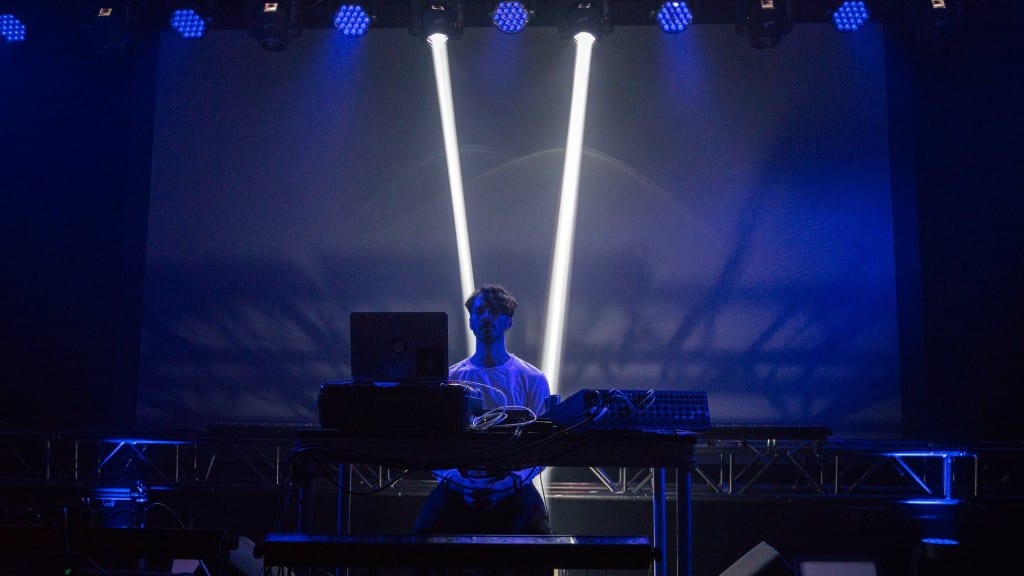 Credit: Trung Dung Nguyen
Credit: Trung Dung Nguyen
Calmly imbibing a Sapporo, his hands resting mostly in his lap, Senni fucked with the crowd six ways from Sunday, never once letting things reach climax. I left the room about twenty minutes in, the volume a little bit too much for my unprotected ears. When I returned, a little while later, he was still going at it, ramming two decades worth of rave detritus through the speakers. I couldn’t help but chuckling to myself. I wasn’t the only one.
And then! One of the longest fade-outs I’ve ever heard. Is the performance over? Should we clap? No wait… Wait… Suddenly two liquid nitrogen cannons erupted high over the stage, spewing icy clouds of gas, Ibiza-style, down upon our heads. It was a hilariously fitting last touch to what was surely one of the ballsiest performances of the festival.
SPACE IS THE PLACE
Electronic music, it seems, has always been enamoured with outer space – they both belong to the future in the same way that classical music and the Enlightenment now belong to the past. I couldn’t help but notice that the space theme was alive and well in the work of some of this year’s MUTEK artists.
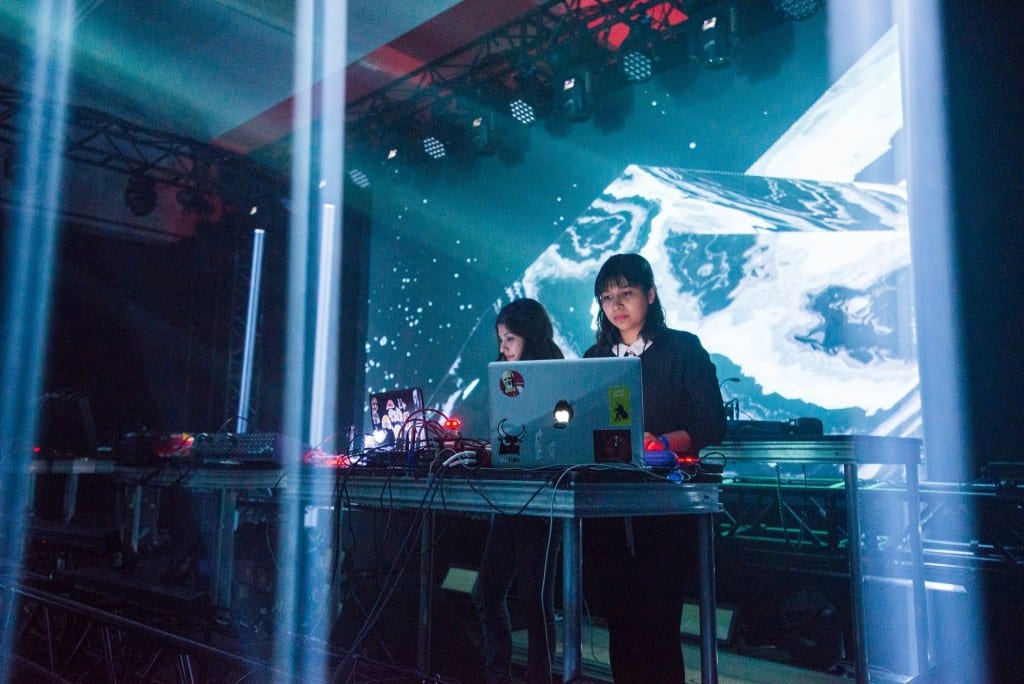
Credit: Trung Dung Nguyen
Mexican multimedia artist and musician, Laura Luna, as her name suggests, was preoccupied with conjuring a distinctly lunar atmosphere. Synthetic blips and bass tones, melodic drones, and dry cricket-like chirps were the soundtrack to a visual presentation that began with black and white shots of the moon’s surface bleeding in and out of focus to increasingly frenetic rhythms. This was followed by squishy organic sounds layered over more hypnotic drones, the visual component consisting of a microscopic close-up of what appeared to be a human scalp spinning towards the viewer like a planet on it’s x axis, its forest tangle of hair follicles continually looming into view. One got the impression that Luna was drawing parallels between the macro and the micro. As above, so below, as it were.
Working strictly on the macro level, Russian techno artist Dasha Rush’s collaboration with visual artist and compatriot, Stanislav Glasov, for the A/Visions performance, Dark Hearts of Space, was an eerie metaphysical study of black holes. Taking place in the two-story Salle Pierre-Mercure in the Centre Pierre-Péladeau, the visual aspect involved several transparent screens that were used to create a riveting 3D effect as various iterations of the galactic phenomena got projected in multiple layers. Wispily outlined at first, the black holes gradually took on the appearance of computer-generated lattices, and then darting schools of spermatozoa, before settling into more solid concentric rings like the grooves in a vinyl record. Rush’s ambient score was appropriately lushly layered and mysterious sounding, culminating in a heavenward crescendo that left me feeling, when the lights came on, a little bit wrung out and disoriented, like I had just returned from plumbing the depths of the universe.
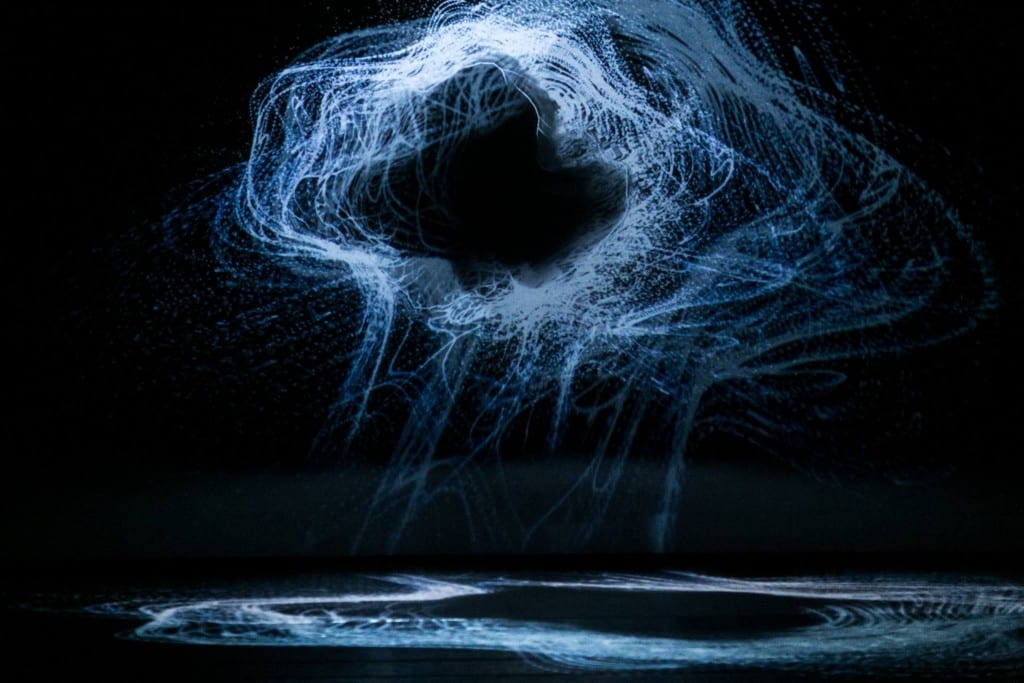
Credit: Vivien Gaumand
I ACTUALLY LIKE AMBIENT
Incorrigible beat junky that I am, any mention of ambient music usually triggers my yawn reflex and gets my eyes rolling. I was surprised to learn, then, that I actually really enjoy the stuff. Certain ambient performances at MUTEK had me feeling like I was adrift in a vast sea of emotive sound. Joy and gloom were both to be found in abundance, as well as many in-between emotions that were hard to put a name to.
Montrealer Tim Hecker’s performance produced all of these feelings in me, almost simultaneously. I had long heard of Hecker as being synonymous with MUTEK, and can even remember hearing a few tidbits of his work on festival programmer Patti Schmidt’s now defunct CBC radio show, Brave New Waves, but had never had the pleasure of hearing one of his powerful performances in person. The excitement in the crowd was palpable as the main room of the MAC began to fill with artificial fog in the minutes leading up to his appearance at Nocturne 2.
The production began in smudgy darkness with sustained, orchestral chords slowly swelling and building in intensity. Stationed behind an array of LED lights that stretched the length of the stage, with another array above and behind him, Hecker’s blurred silhouette gradually came into view as, one by one, the rows of LEDs began to gently flicker like so many votive candles.
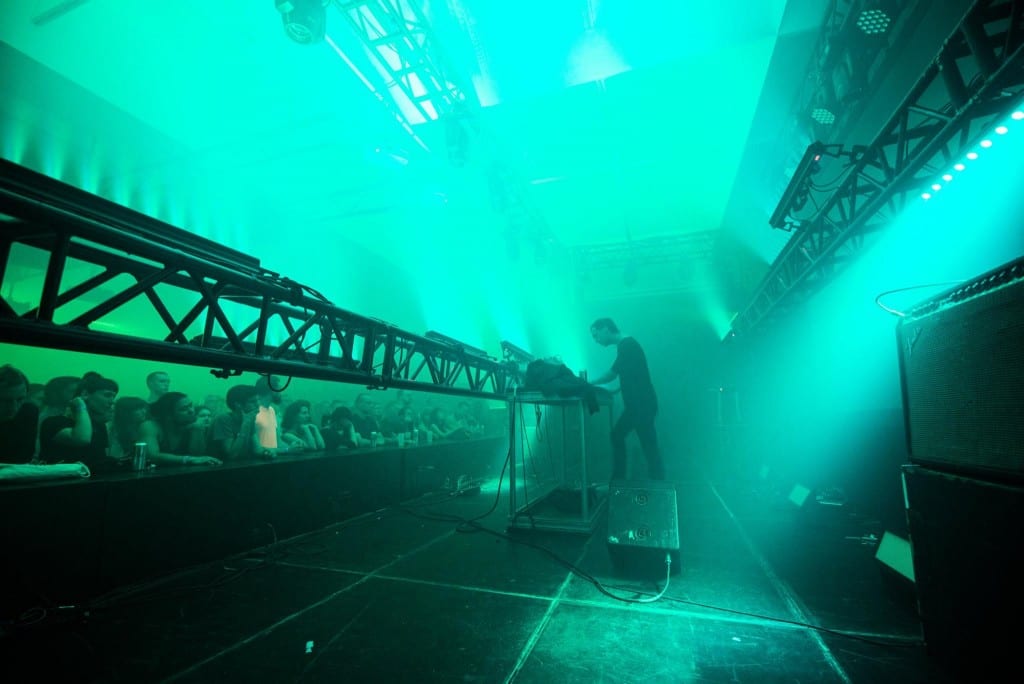
Credit: Trung Dung Nguyen
Pale blue at first, and then brighter and brighter as the music, incredibly lush and joyful, reached greater heights of feeling, the twinkling lights, as seen through the fog, gave the whole thing a double touch of the sacred and the profane, like a holy mass and rave rolled into one. As the music began to descend in pitch and become more cacophonous, the lights began to flicker more rhythmically and their bluish hues gave way to pinks and reds as if symbolizing a shift from the sublime to the infernal. This was followed by a transition to what I’m tempted to call a purgatorial state, wherein the LEDs flickered palely yellow and orange, subtly involving themselves with gentler clavier-like sounds. Then there came a stroboscopic finale where blue light and red, along with their sonic equivalents, seemed to clash it out in a good old fashioned end-of-days battle between good and evil. At least, that was my black and white (or red and blue) interpretation of it. There was no clear victor to speak of in the end, but is there ever really?
MONTREAL’S GOT TALENT
Maybe not the go-hither-on-nationwide-television-and-give-the-soft-domed-plebes-exactly-what-they-want-to-hear kind of talent. I’m talking more about the spend-your-tuition-money-on-a-909-and-live-on-rice-crackers-and-rainwater-until-you-make-it-in-the-underground sort. We seem to have that in spades.
I didn’t get a chance to catch all the locals appearing at the festival, but the performances I did take in were impressive. One of the great things about MUTEK, and this seems to get brought up again and again, is how it provides a platform for emerging Canadian acts to rub shoulders with more established international artists. The organization seems intent on developing local talent and, at the same time, fostering a community that spans the globe. Many of the Montreal artists I had the pleasure of seeing this year are just starting to make their first splashes on the worldwide scene, and one can only hope that this bit of exposure will help them take things even further.
Highlights included RIOHV, who is a recent transplant to Montreal from Ottawa, and has lately released on house-label-of-the-moment, 1080p. Taking his place on the outdoor Experience stage on day two, he played a solid live set that had everybody smiling and feeling the funk despite the light rain coming down.
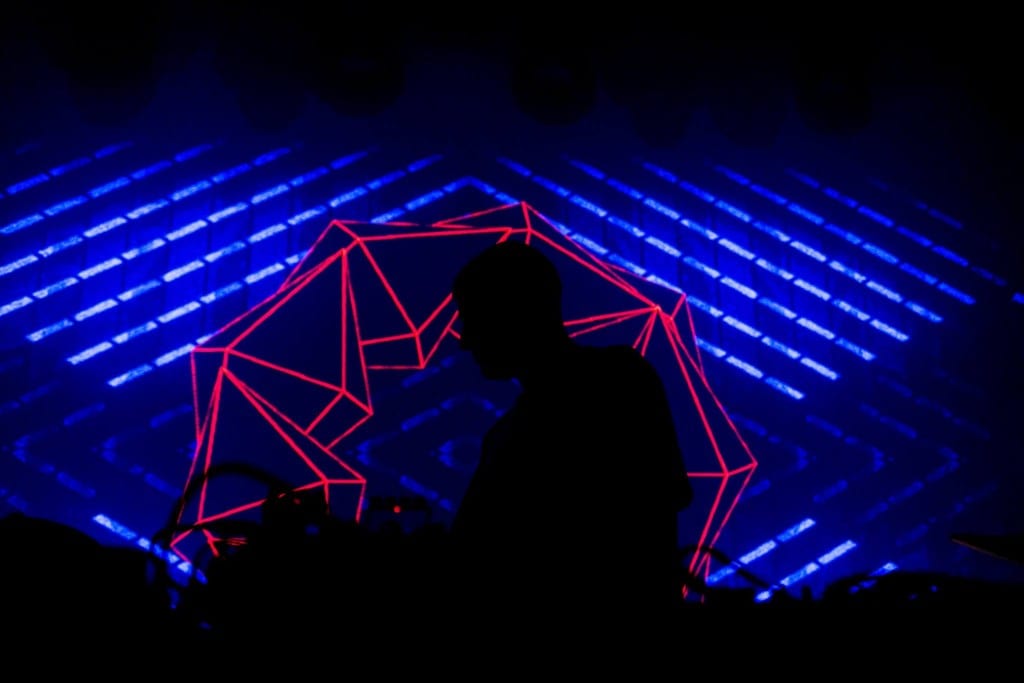 Credit: Vivien Gaumand
Credit: Vivien Gaumand
In a similar house vein, there was Project Pablo, who helped to close out the festival with a live set at the MAC. Another newcomer to Montreal, both his love for the city and the city’s love for him were on full display when he performed tracks from his recent Beaubien Dream EP, named for the neighbourhood he now calls home. Boy, can this guy write a catchy melody. When he played the pads from his standout track, “Closer,” the crowd erupted in knowing applause. Later that night, I actually heard a dude whistling the same tune in the washroom.
Lastly, one of the biggest revelations I had at the festival came while listening to the otherworldly compositions of Kara-Lis Coverdale. Coverdale, who until recently was employed as an organist at St. John’s church in Montreal, unveiled a live set that was akin to what devotional music might sound like in some future utopia. Pipe organ, piano and choral elements intermingled with layer upon layer of resounding drones and profound bass. It was all very New Agey without ever falling into cliché, a kind of newfangled church music for people who don’t buy into religion.
NOCTURNE 04
It’s not like I’ve been to a lot of niche festivals like MUTEK (actually none, to be honest), but one gets the feeling that they are at the absolute top of the heap when it comes to programming. Except for a very few hiccups, it felt like there was an underlying intelligence at work the whole way through.
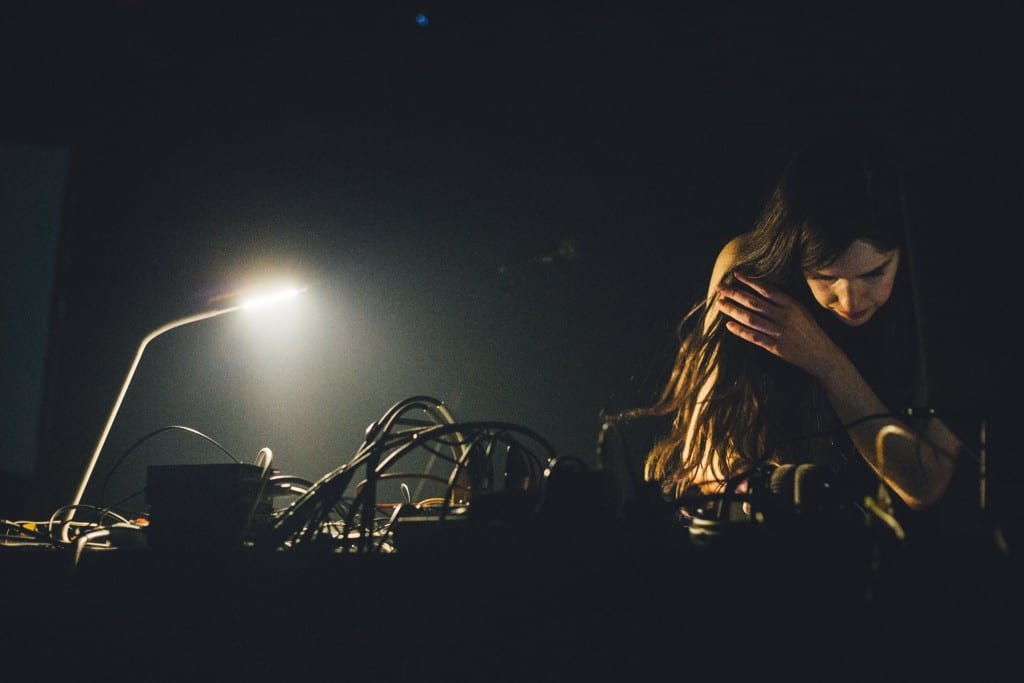
Credit: Ashutosh Gupta
Nocturne 04, to be sure, suffered from one of those hiccups, but it was also one of my favourite nights of the entire week. Beginning auspiciously with a spirited performance by Montreal dark wave darlings, Essaie Pas, the main room of the MAC was set to go into party mode when things took a strange turn with the inclusion of UK techno artist, Powell, on the bill.
Powell’s live set was overtly punk in its delivery, employing brash sonic trickery and rapid fire cuts between material. It was also a bit of a flop. Much to the British artist’s dismay, the crowd couldn’t seem to make heads or tails of his riotous set, only beginning to move their feet when he worked in classic 80’s samples or took a more classic techno approach. Despite his failure to move the Montreal dance floor, you had to admire the guy’s Johnny Rotten antics. After goading people to dance (or fight) for a good hour, he actually threw an empty beer can at the audience before walking off stage!
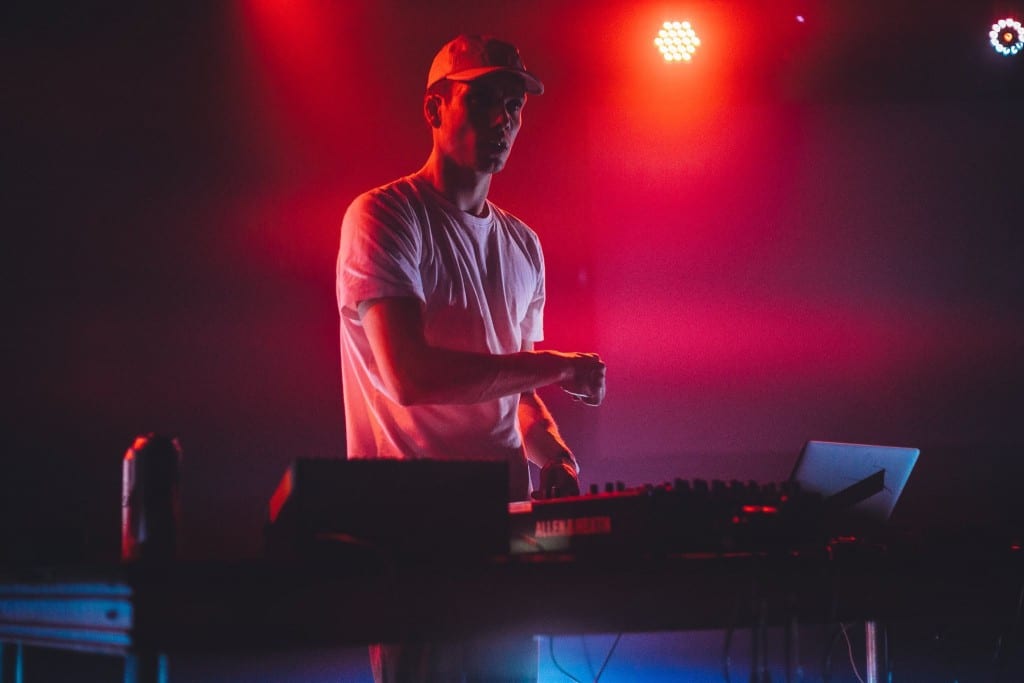
Credit: Ashutosh Gupta
Brooklyn techno sage Terekke’s live set, which followed, was quite a few steps back down the ladder in terms of energy. As deep and as beautifully-restrained as they were, his smoked-out analogue jams might have made more sense at the beginning of the evening, or better yet, at some off-festival loft party at five in the morning.
Despite the somewhat confusing running order, the final act of the night, American DJ and producer, Galcher Lustwerk, did everything but disappoint. He ended up playing one of the best DJ sets I’ve heard in a long time. Starting off with a hip hop monologue over a soft ambient track, he then launched into 90’s gangster rap and 60’s folk-pop before diving into the heady strains of house and techno he’s known for, every now and then rapping over his own productions like it was no big deal. When Sade’s “Hang On To Your Love” came on at the very end, and the dancers trotted out their last moves, it was one of those perfect festival moments, another gem in an already long line of them.
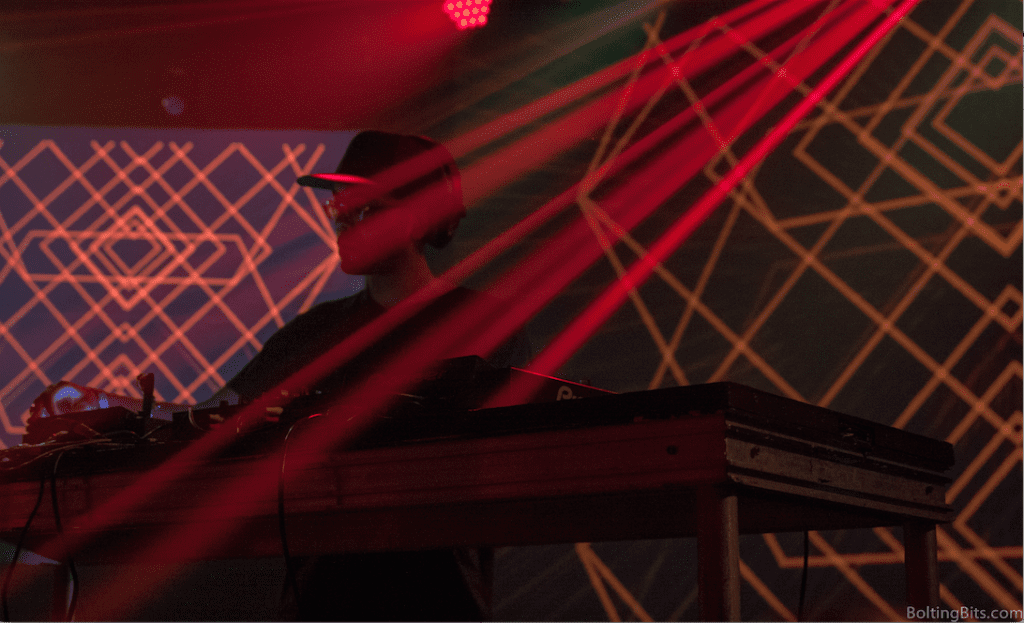
Erik Faulkner

